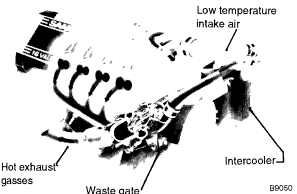 |
|
..:: SAAB FAQ :: 900 Old Generation :: Бентли :: Часть 1 ::..Fundamentals for the Do-it-yourself Owner 100-1
GENERAL Although the Saab 900 is a sophisticated and complex machine,nearly all basic maintenance and most repairs can be accomplished by any interested owner with basic mechanical skills and the right information. While some of the repairs covered in this manual are complicated and require special knowledge and equipment, most of the care that is required in the lifetime ofthe average Saab is well within the capabilities of the do-it-yourselfer. CAUTION Do not use this manual unless you are familiar with basic automotive repair procedures and safe workshop practices. This manual illustrates the workshop procedures required for most service work; it is not a substitute for full and up-to-date information from the vehicle manufacturer or for proper training as an automotive technician. Note that it is not possible for us to anticipate all of the ways or conditions under which vehicles may be serviced or to provide cautions as to all of the possible hazards that may result. CAUTION Your common sense and good judgment are crucial to safe and successful service work. Read procedures through before starting them. Think about whether the condition of your car, your level of mechanical skill, or your level of reading comprehension might result in or contribute in some way to an occurrence which might cause you injury, damage your car, or result in an unsafe repair. If you have doubts for these or other reasons about your ability to perform safe repair work on your car, have the work done at an authorized Saab dealer or other qualified shop. This section of the manual is intended to help the beginner get started smartly and safely with Saab maintenance and repair. The section begins with Form and Function, a general description of the car and its individual systems, followed by a discussion on How To Use This Manual. Tips on mechanic's skills and workshop practices that can help the beginner do a faster, complete, and more thorough job can be found under Getting Started.Tools describes the basic tools needed to do most of the procedures in this manual. The section ends with a quick reference guide to emergencies — what to do when the car won't start or when a warning light comes on, including basic troubleshooting and information on how to gauge the seriousness of a problem. FORM AND FUNCTION While the complexity of the Saab 900 may at first seem over whelming to the do-it-yourself owner, it can be simplified and more easily understood by viewing the car as an assembly of simpler systems, each performing its own independent functions. Engine The Saab 900 models covered by this manual are powered by a liquid-cooled, four-cylinder, 16-valve, in-line engine. The power train is integrated with the clutch, transmission, and differential in a compact,lightweight power unit that occupies very little space. See Fig. 1.
Fig. 1. Cutaway of Saab 900 16 valve over head camshaft engine. The engine is sloped at 45% to lower the car's center of gravity and to allow for a low hood line. The transmission is bolted to the bottom of the engine. The 16 valve cylinder head uses self-adjusting hydraulic cam followers to actuate the valves. Each valve has a large flow area to allow the engine to breath efficiently. Because the cylinder head has four valves per cylinder instead of two, individual valves are subject to far less demanding working conditions. See Fig. 2.
Fig. 2.Cutaway view of valve train Saab Turbo with APC In addition to the naturally aspirated engine family, the 900 is available with a turbocharged engine. See Fig. 3.
Fig. 3. Cutaway of turbocharger system. The intake air is compressed by the exhaust-driven turbocharger. It is then cooled by as much as 110°F in the intercooler before it enters the engine. The intercooler increases power and reduces the thermal stresses in the engine. The turbo engine delivers extra power at low engine speeds when demanded, but during normal driving it is as economical as the naturally aspirated engine. The turbocharged engine offers the same acceleration as many six-cylinder and eight-cylinder engines, but without the well-known disadvantages of excessive weight, unwieldy bulk with too many moving parts, and high fuel consumption. Safety margins must be built into the design of an internal combustion engine to allow for manufacturing tolerances, changes in the condition of the engine, and varying climatic conditions and fuel quality. As a result, the energy content of the fuel cannot be fully utilized. To answer this problem, the Saab APC system was designed to ensure maximum utilization of the energy in the fuel at all times. The boost pressure delivered by the turbocharger is continually adjusted to suit the knocking limit of the air/fuel mixture in the cylinders. Therefore,the engine adjusts itself automatically to the fuel being used. The higher the octane, the higher the maximum engine power. See Fig. 4.
Fig. 4. A conventional engine must incorporate safety margins for engine tolerances, various climatic conditions, and variations in fuel grades available. The Saab APC turbo engine adjusts itself automatically to suit the operating conditions. NOTE On Saab Turbo SPG models, premium unleaded fuel is required at all times. |
| SAABNET.RU | Форум SAABNET.RU |
|
|



